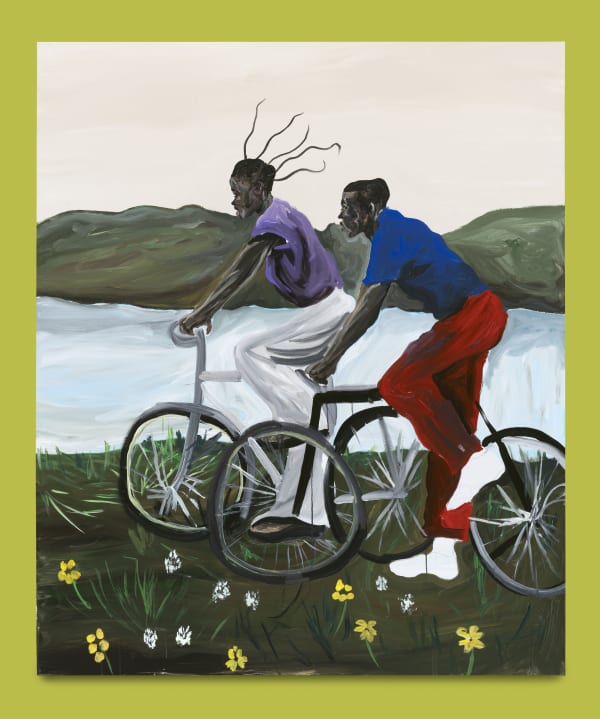"POETICS OF EXILE" MARCUS BRUTUS: Paris
As a new figure of “Black Figuration”, Brutus could follow in the footsteps of Jacob Lawrence or Kerry James Marshall, whom he claims as influences; or Lynette Yiadom-Boakye, whose paintings all converge towards the same goal: to make the everyday life of people of color exist through painting, where before they were often absent, or often objects of fantasy and exoticism, all while avoiding the illustration of suffering. In Marcus Brutus’ work in the portrait genre which he is so fond of, his gestures are an act of renewal: straight lines are almost always absent, giving way to sinuous contours that undulate and distort the silhouettes slightly. Fixed in permanent movement, which may recall certain great symbolist or expressionist works, each element of the canvas becomes flexible, almost liquid, depicting the characters with a certain vulnerability. The artist uses scenery and clothing colors that awaken the scenes with their liveliness and bright contrast. Interested in this game of chromatic percussion, the spectator then comes to feel in the complexity and precision of the faces all the emotion transmitted by their expressions.
As his practice evolves, Marcus Brutus masters a paradoxical balance: that of exploring ever-more precise and rarely represented subjects with the goal of delivering the most universal vision of humanity possible. For his first solo exhibition in France, the thirty-year-old has immersed himself in the history of Haitians who left their country for Canada between the 1960s and 1980s, from their flight from Papa Doc’s dictatorship to their often laborious integration into the North American country. Recounted by Sean Mills in the book A Place in the Sun: Haiti, Haitians, and the Remaking of Quebec, this little-known part of 20th century history inspired the painter to create fifteen peaceful and poetic canvases, far from a historical or didactic rendition of the facts. From one work to another, the characters – often alone or in pairs – appear in diverse scenes, all linked by a common point: displacement. On horses or bicycles, on board a boat or in airport corridors, these men and women, mostly static, embody the physical and psychological state of waiting, of being in transit, between their land of birth and their new and final destination. This “poetics of exile”, as the title of the exhibition indicates, then also becomes a poetics or a questioning-through- painting the potentiality of a situation that is often forced and which still affects millions of people around the world today. As Maya Angelou also wrote, “There is no greater agony than bearing an untold story inside you,” Marcus Brutus seems to respond optimistically, exploring the past for artistic purposes and countering the consequences of this suffocating silence and ignorance, and ideally forming a key to inner peace.
– Matthieu Jacquet
-
 Marcus BrutusLotus Blossom, 2022Acrylic on canvas91.4 x 76.2 cm.
Marcus BrutusLotus Blossom, 2022Acrylic on canvas91.4 x 76.2 cm.
36 x 30 in. -
 Marcus BrutusThreaded Journey, 2022Acrylic on canvas152.4 x 121.9 cm.
Marcus BrutusThreaded Journey, 2022Acrylic on canvas152.4 x 121.9 cm.
60 x 48 in. -
 Marcus BrutusPleasures of Vacation, 2022Acrylic on canvas152.4 x 121.9 cm.
Marcus BrutusPleasures of Vacation, 2022Acrylic on canvas152.4 x 121.9 cm.
60 x 48 in. -
 Marcus BrutusIn Search of a Place in the Sun, 2022Acrylic on canvas152.4 x 121.9 cm.
Marcus BrutusIn Search of a Place in the Sun, 2022Acrylic on canvas152.4 x 121.9 cm.
60 x 48 in. -
 Marcus BrutusUn Petit Conte de la Mer, 2022Acrylic on canvas177.8 x 152.4 cm.
Marcus BrutusUn Petit Conte de la Mer, 2022Acrylic on canvas177.8 x 152.4 cm.
70 x 60 in. -
 Marcus BrutusUnhappy Departure , 2022Acrylic on canvas152.4 x 121.9 cm.
Marcus BrutusUnhappy Departure , 2022Acrylic on canvas152.4 x 121.9 cm.
60 x 48 in. -
 Marcus BrutusHalte A La Surpeche, 2022Acrylic on canvas121.9 x 101.6 cm.
Marcus BrutusHalte A La Surpeche, 2022Acrylic on canvas121.9 x 101.6 cm.
48 x 40 in. -
 Marcus BrutusTeach Me Today, 2022Acrylic on canvas182.9 x 152.4 cm.
Marcus BrutusTeach Me Today, 2022Acrylic on canvas182.9 x 152.4 cm.
72 x 60 in. -
 Marcus BrutusStreet Vendor, 2022Acrylic on canvas152.4 x 121.9 cm.
Marcus BrutusStreet Vendor, 2022Acrylic on canvas152.4 x 121.9 cm.
60 x 48 in. -
 Marcus BrutusLes Gués de L'Amour, 2022Acrylic on canvas121.9 x 101.6 cm.
Marcus BrutusLes Gués de L'Amour, 2022Acrylic on canvas121.9 x 101.6 cm.
48 x 40 in. -
 Marcus BrutusLittle Red Fantasy, 2022Acrylic on canvas152.4 x 121.9 cm.
Marcus BrutusLittle Red Fantasy, 2022Acrylic on canvas152.4 x 121.9 cm.
60 x 48 in. -
 Marcus BrutusAfter Mandabi, 2022Acrylic on canvas152.4 x 121.9 cm.
Marcus BrutusAfter Mandabi, 2022Acrylic on canvas152.4 x 121.9 cm.
60 x 48 in. -
 Marcus BrutusHaitian Interiors, 2022Acrylic on canvas152.4 x 121.9 cm.
Marcus BrutusHaitian Interiors, 2022Acrylic on canvas152.4 x 121.9 cm.
60 x 48 in. -
 Marcus BrutusEmmêlement , 2022Acrylic on canvas182.9 x 152.4 cm.
Marcus BrutusEmmêlement , 2022Acrylic on canvas182.9 x 152.4 cm.
72 x 60 in. -
 Marcus BrutusLi Dous Konsa, 2022Acrylic on canvas183 x 153 cm.
Marcus BrutusLi Dous Konsa, 2022Acrylic on canvas183 x 153 cm.
72 x 60 in. -
 Marcus BrutusWeaver of Dreams, 2022Signed and dated on the backAcrylic on canvas152.4 x 121.9 cm.
Marcus BrutusWeaver of Dreams, 2022Signed and dated on the backAcrylic on canvas152.4 x 121.9 cm.
60 x 48 in. -
 Marcus BrutusThat Was Yesterday, 2022Acrylic on canvas182.9 x 152.4 cm.
Marcus BrutusThat Was Yesterday, 2022Acrylic on canvas182.9 x 152.4 cm.
72 x 60 in.

















